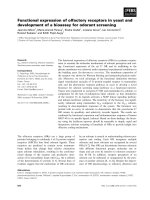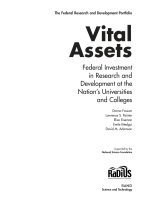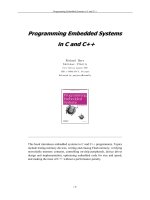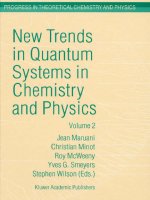electronic trading systems in europe and development potentialities for russia
Bạn đang xem bản rút gọn của tài liệu. Xem và tải ngay bản đầy đủ của tài liệu tại đây (1.22 MB, 29 trang )
Folie 1
Elektronische Handelssysteme in Europa und
Entwicklungsmöglichkeiten für Russland
Electronic Trading Systems in Europe and development
potentialities for Russia
Workshop:
Bank und Finanzbeziehungen in Europa und die
Integration Russlands
Prof. Dr. Christoph Lattemann
Chair for Corporate Governance and E-Commerce
Folie 2
Agenda
1. Theoretical Background (Market Microstructure Theory)
2. Structure in Germany
3. Structure in Europe
4. Structure in Russia (Discussion)
Folie 3
Impact of Liquidity and Degree of
Automation on Efficiency
Main goal of markets: Efficient resource allocation
Measure of the market’s efficiency: transaction and liquidity costs
• Development of efficient market models and trading platforms
Characteristics of the
structure
Factor for Efficiency
Criteria for Efficiency
Effect
Evaluation
Transaction Costs
Picot et al. [1996]
Price Steadiness
Information efficiency
Transparency
Integrity
Regional Concentration
Liquidity
= Effect
= trade-off
Marktkonzentration
Price finding
mechanism
Market Organization
Orderbook Transparency
Frequency
Legal Bounderies
Computerization
Theoretical Background – Market Microstructure Theory
Folie 4
Transaction Costs on Equity Markets
Liquidity
Computerization
(Transaction Costs)
Folie 5
Folie 6
„Eine Automatisierung der Informations-, Orderrouting,
Abschluss- und Abwicklungsphase führt ohne
Einschränkungen zu einer effizienteren Organisation des
Transaktionsprozess von Wertpapieren. Entsprechend ist die
Automatisierung dieser Phasen ohne Einschränkung
erstrebenswert aus dem Gesichtspunkt der Effizienz.“
The computerization of the Information-, Orderoruting-, Matching-, and
Settlement-Phase leads to an efficient organization of the transactions
process of security trading.
Insofar, from the point of efficiency, it is desirable to computerize all
processes.
Picot et al. 1996, Börsen im Wandel
Folie 7
Agenda
1. Theoretical Background (Market Microstructure Theory)
2. Structure in Germany
3. Structure in Europe
4. Structure in Russia (Discussion)
Folie 8
Structure in Germany
Market Share
(Exchange
traded equities)
98 %
München
Hannover
(Commodity Exchange)
Hamburg & Hannover
Berlin
Bremen
(Nasdaq Deutschland)
Frankfurt
Xetra
Eurex
Exchange OTC
Equities 55 % 45 %
Bonds 10 % 90 %
Leipzig
(Power Exchange)
Düsseldorf
Stuttgart
Folie 9
The Strategy of the regional exchanges
focus on niche markets
and develop their own trading systems
Japanese Stocks
Options
Services for small and medium sized
Companies
10.000 international Stocks from more
than 60 Countries
6000 US Stocks
> 800 Asian Stocks
1500 Bonds,
> 250 Stock options
Funds-X
Turkish Stocks
American Stocks
Specialization
Quotrix (Autumn 2001) Düsseldorf
EUWAX (automatic Orderrouting via
Xontro, Matching by Market Maker )
Stuttgart
Nasdad Europe (ab März 2003)Bremen
Nasdaq Europe (since March 2003)Berlin
MAX-ONE (since May 2003) Munich
Hamburg and
Hanover
(BÖAG)
Trading SystemExchange
Folie 10
Trend toward Internalization in Germany
Competition due to Internalization
Max Blue
No
Deutsche
Bank
Referenzbör
sen
2003
PIP/
Maxblue
Frank-
furt
FrankfurtMunichDüssel-
dorf
Bremen/
Berlin
Home Exchange
all
Comdirekt,
Commerzba
nk,Hypverei
nsb.,
Santander
Almost
alle
S-Broker,
Fimatex,
1822
direkt
HypoV.,Dres
d.,
Comdirekt,
Consors,
Commerzba
nk
Access by banks
YesNoYesYesYes
Official Price
9-209-20 Uhr9-20 Uhr8-23 Uhr9-20 Uhr
Trading Hours
19972002200319982003Launch
XetraXetra BestMax-OneQuotrixNasdaq D
Quelle:: Faz-Sonntagszeitung, Nr. 11, 16.3.03 S. 45
Folie 11
Xetra provides a wide range of market models
and functionalities on a single trading platform
Continuous
trading
interacting
with
Auctions
Xetra Best
Retail Trading
Trading Model
for High &
Medium
Liquids
Xetra XXL
Block Trading
Continuous
auction
Warrant & Less
Liquid Trading
Single/
Multiple auction
Less Liquid
Trading
Xetra OTC
OTC Trading/
Reporting
… and therefore enables maximum flexibility for the
market provider and the market participants
Source: German Exchange
Folie 12
Deutsche Börse Group – a “Markets Company”
Customers: issuers, investors, intermediaries, information vendors, exchanges
Deutsche Börse Group
Deutsche
Börse
Systems
Derivatives Trading
Information Products
CashTrading
DAX
DAX
DAX
Third party technology services
B2B Markets
Clearinghouse/Central Counterparty (CCP) Eurex Clearing
Settlement and Custody
Source: German Exchange
Folie 13
Agenda
1. Theoretical Background (Market Microstructure Theory)
2. Structure in Germany
3. Structure in Europe
4. Structure in Russia (Discussion)
Folie 14
Characteristics of the European Equity Market
High degree of fragmentation
• Differences in market practices
• Language differences
• Cultural differences
Less developed equity culture as in the U.S.
• Lower market capitalization
Folie 15
The European Landscape of Exchanges
Athens SE
OM Group
Madrid SE
Milano SE
Swiss Exchange
German SE
London SEEuronext
Malta
Irish SE
Viennna SE
Lissabon SE
Low
High
Market Share
Trading System and sophsticated
IT Competence
Source: Accenture 2000
(Floor)
(OTC)
High
Low
Folie 16
No common platform and
no common architecture in Europe
Derivative Exchange Cash Exchange
Belgium NSC - VF NSC
Denmark OM SAX
Germany Eurex Xetra
Finland Eurex HETI
France NSC-VF(evtl.Connect) NSC
Greek Own Own
UK Connect SETS
Irland Xetra
Italy OM Own
Netherlands Floor (later Connect) NSC
Norwegian OM Own
Austria OM Xetra
Portugal MEFF TRACS/QUOTE Own
Sweden OM SAX
Spain MEFF TRACS/QUOTE SIBE
Swiss Eurex EBS
⌦ There are 6 different
trading platforms at the
European derivative
markets and 12 at the
European Cash Exchanges
Folie 17
Drivers of Efficiency & Innovation
Trends in Europe
Horizontal cross-border competition
Increasing competition across the entire Securities Industry
• Cash equity markets (Dt. Börse; LSE)
• Derivatives markets (Eurex; Liffe)
• Cash bond markets (Eurex Bonds;BrokerTec;others)
Competition between market organizers and intermediaries
Disintermediation policy of Market Organizers (Exchanges, CDSs, Clearing
Houses)
Internalization policy of Intermediaries (Brokers,Custodians)
Advanced technology and high innovation
Early introduction of electronic trading systems
Development of central counterparty for equity trading (ECPP) as the new industry
standard
Demutualization
Folie 18
Electronic Communication Networks
and Internalization as Competitors for Exchanges
Nasdaq
Technological development
Costumer needs
(De-)Regulation
Reuters
Instinet
Strike
REDIBook
Archipelago
BRUT
NextTrade
TradeBook
ISLAND
Attain
JP Morgan
Goldman Sachs
Merrill Lynch
Sal Smith Barney
Heine
Herzog
DLJ
Lehman
PaineWeber
Bear Stearns
SLK
TD WaterhouseFidelity
Schwab
Townsend
South Western Sec
Gary Putnam
E-Trade
CNBC
Morgan stanley Dean Witter
ASC Sunguard
Knight Trinkmark
Bloomberg
PIM
All Tech
TA Associates
LVMH
Datek
Platforms for Internalization
by Broker/Dealer and Banks
Folie 19
The Development of ECN´s in Europe
Prime Access
XEOS
Cats OS
Jiway
TLX
MLX MarketEdge
Knight
Virt X
E-Crossnet
Retail
Traditional Exchange
Service
Institutional
Target Client Group
Type of Service Offered
Complementary
Specialists
X
X
X
(X)
X
Posit
Tradegate
Tradecross
Low
Source: Accenture 2000
Folie 20
Demutualization– Change in the Governance Structure
1986
Membership
corporation
All
Exchanges
1992
1993
1995
1996
1997
Not listed for profit
organizations
Soc. des Bourses
Françaises
Deutsche Börse AG
Stockholm SE
Helsinki SE
Copenhagen SE
Amsterdam SE
Borsa Italiana
listed for profit
organizations
•OM
LIFFE
LSE
London Metal
Exchange
(Nasdaq Inc.)
Deutsche Börse AG
Euronext
Borsa
Italiana
1998
1999
2000
2001
2002
Folie 21
Trend Toward Cooperation and Mergers
Most projects were not successful in Europe
– Failure of merger between LSE an German Stock Exchange (iX, September 2000)
– Failure of „pan-European“ Exchange for „young“ Companies
(Easdaq, Brussels; Spring 2001)
– Failure of „ pan-European“ Market-Maker-Exchange Jiway, London,
Autumn 2002)
– Failure of the Merger of the biggest European Settlement Institutions
(Euroclear and Clearstream) (Spring 2002)
– Merger of Crest – LCH successful
– Merger of Cedel– German Kassenverein successful
- Merger of Suffix-DTB successful
Folie 22
3 Networks cover 75 % of the
Settlement volume in Europe
Settlement
institution
Trans-
action
volume in
2000 in
Mio. €
Assets
in Mrd.
€
%-
share
in
Europa
Operation Costs
in Mrd. €
(Operation Costs
/Transactions
)
Ownership Structure
Euroclear plc
145
7.424 31 %
Ca. 420 Mrd €
(EUR 2,9 each
transaction)
83,33 % Euroclear
16,67 % Sicovam
AG with over 1500
Stockholders
Clearstream 153 7.420 31 %
Ca. 420
(EUR 2,75)
100% Deutsche
Börse AG
The Settlement
Network 88 4.000 16 %
Ca. 140
(EUR 1,6)
SIS und CrestCo
AG with each over
100 stockholders
Rest of Europe
(1999)
62,6 5.382 22 %
Folie 23
The New Trend: Concept of Central Counterparty
on Cash Markets in Europe
Central Counterparty is established for
long time at derivative markets
At first at U.S. Cash Market (1977
NSCC)
Now Proactive Initiatives for the
introduction of CCP in Europa
London
Frankfurt
Brüssel
Paris
Borsa Italiana
(2002)
Mailand
LSE (2001)
virt-X (2002)
Euronext
(seit 1990)
Paris
Brüssel
Amsterdam
Xetra (2003)
FWB Parkett
(2003)
Amsterdam
Oslo
Stockholm
Kopenhagen
Reykjavik
Norex
(2004)
CCP Introduced
Introduction is planed
Quelle: Deutsche Börse 2003
Folie 24
Agenda
1. Theoretical Background (Market Microstructure Theory)
2. Structure in Germany
3. Structure in Europe
4. Structure in Russia (Discussion)
Folie 25
Market Capitalization
556,6Toronto Stock Exchange
37,2Russia
596,3Swiss Exchange
993,1Deutsche Börse
1 692,7EURONEXT
2 060,0London Stock Exchange
2 504,5Tokyo Stock Exchange
2 517,5NASDAQ
10 247,0New York Stock Exchange
Marktkapitalisierung in Mrd. USD
in 2001









![extreme weather and financial markets [electronic resource] opportunities in commodities and futures](https://media.store123doc.com/images/document/14/y/ok/medium_okc1401382446.jpg)